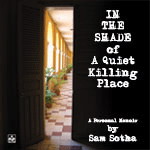A path through history by Sanitsuda Ekachai (Outlook, Bangkok Post).
A research project between Thailand and Cambodia sheds light on the ancient Angkor-Phimai road, which has been shrouded in mystery for centuries.The air was full of mystery and danger as we hiked the lush forest in the no-man's-land along the Thai-Cambodian border looking for archaeological remnants of the long lost Angkor-Phimai royal road. "Stay on the path," Col Surat Lertlum solemnly warned, pointing to a cluster of what looked like round plastic lids near a thicket two metres away. "The forest is still full of land mines and we can only guarantee your safety if you stay on the path." Obediently, we followed him along the narrow path until the moist earth under our feet turned rocky as we stepped onto a raised laterite walkway supported by an embankment made of layers of laterite rocks. We were at the Ta Muean mountain pass on the Phanom Dongrak mountain range, a natural boundary between Surin province in Thailand's northeast and Oddar Meanchay province in northern Cambodia. "This is where the ancient road, which passed through the plains in Cambodia, climbed up the mountainous forest of Phanom Dongrak to the plateau in Thailand before heading toward Phimai," explained Col Surat.
Apart from the laterite embankment, other archaeological evidence of the ancient Angkor-Phimai route at the heavily-mined Ta Muean Pass includes stone pillars that once lined the road, remnants of decorative sculptures, a small laterite bridge and a laterite cutting site that provided building materials for the road. This connecting point at Ta Muean is one of the important discoveries made by the Living Angkor Road Project, a Thai-Cambodian joint effort supported by the Thailand Research Fund to explore the 254-kilometre route that linked Angkor and Phimai when the Khmer civilisation reigned. The road started at the western gate of the Angkor Thom temple and ended at Phimai, an ancient city believed to have had close royal links with the Angkor dynasties. The knowledge of the route is not new. A 12th century stone inscription from Preah Khan Temple near Angkor Thom states that King Jayavarman VII, a great Mahayana Buddhist king, ordered the construction of 17 temples along the Angkor-Phimai road as rest stops for travellers.
Originally called agnisala, meaning "houses of fire" that travellers could see lit-up from afar at night, these rest houses have become popularly known as dharmasala through L. Finot's studies in the 1920s on the architecture of the rest chapels. Prior to the Living Angkor Road Project, archaeologists had identified the sites of 15 of the 17 dharmasalas built along the road, but the exact route it took had never been located. There was a widespread belief among archaeologists that the road passed through the Phanom Dongrak mountain range at the Samed pass, near the famous Prasat Phanom Rung temple. The Living Angkor Road Project has proved this wrong.
By integrating modern technology in remote sensing, geographical information systems (GIS) and geophysics along with conventional studies in archaeology, anthropology and history, the project has identified Ta Muean as the connecting link over the Phanom Dongrak mountains, which leads directly to Prasat Ta Muean, the first dharmasala or rest stop on the Korat Plateau.
The project has also discovered the remains of the two missing dharmasalas on this route, which are called Ampil and Kok Phnov. The discovery of ancient stone bridges, meanwhile, plots a series of dots that has for the first time revealed the outline of the ancient route from Angkor to Phimai.
Equally important, the research has found a large number of iron smelting and ceramics production sites as well as ancient human settlements within a five kilometre radius of the road. These sites were linked to the main road by networks of smaller roads to transport labour, goods, foods and other resources to the centres of the ancient Khmer empire. Geophysics technologies, said Col Surat, have also been used to accurately locate iron smelting sites, leading to archaeological excavation in Surin's Ban Kruad district earlier this year. Started in 2005, the joint project to unveil the road's mystery is a collaboration between the Chulachomklao Royal Military Academy, the Fine Arts Department, Prince of Songkhla University, Silpakorn University and Cambodia's Apsara authority, which works to protect and manage the Angkor and the Siem Reap region. Thailand's multi-disciplinary research team is led by remote sensing and GIS expert Col Surat Lertlum of the Chulachomklao Royal Military Academy's Department of Mathematics and Computer Science, who is responsible for initiating the project. The Cambodian team is led by Im Sokrithy, an archaeologist from Apsara. "I've long been fascinated by ancient Khmer civilisation," said Col Surat, explaining why he initiated the bilateral effort. Since the use of remote sensing and geography information systems have helped archaeologists pinpoint archaeological sites around the world, I thought my discipline could help shed some light on the royal road." Col Surat began exploring the road with remote sensing and GIS in 2001. "I soon started realising that advanced technologies may significantly speed up archaeological studies, but they are not enough."
Remote sensing, for example, cannot help much when the sites are covered with jungle or when the landscape has been drastically changed by modern farming and construction, he explained.
Archaeology and history, said Col Surat, help fill the gaps by guiding scientific work in the right direction to locate possible survey sites. For ground surveys, however, he has learned that it pays to listen to the locals. For example, scientific studies on topography and the direction of water flows suggested that Ta Muean was the least steep pass and thus the most geographically appropriate for road building. "But it was an old man in the village who told us about an old walkway he used, which led to the discovery of the laterite royal road," said Col Surat.
Archaeologist Im Sokrithy tells a similar story about his discoveries at Cambodian sites.
When searching for the two missing rest chapels, GIS information only roughly identified an area for ground surveys. "It was the villagers' legends relating to the royal road and names of places such as preah kanlong, which means royal road, that gave us the clues as to where the sites should be. "And it was their knowledge of their area which has helped us to identify the dharmasalas, which are always near the ancient royal road," he said. The locals' belief that the road is sacred has helped preserve it for modern-day study, said Sokrithy. Under the scorching sun on our way to see Kok Phnov dharmasala, he pointed to an elevated dirt path flanked by paddy fields. "This part of the royal road still exists thanks to the local belief that damaging it brings bad fortune," he explained.
During the war, recounted Sokrithy, the Cambodian villagers used the little-known road to escape the Khmer rouge. "And it is still being used today to go between villages," he added.
It is also the villagers' knowledge of their localities that has helped the Cambodian team identify 32 ancient stone bridges that together form an outline of the entire Angkor-Phimai royal road.
"Remote sensing technology could never locate this bridge because it is on the same level as the road," said Col Surat while standing on Spean Top, the longest ancient stone bridge on the Angkor-Phimai route. Measuring 149 metres in length and 10 metres high with 25 arches, Spean Top is still in use until today as part of the modern road from Oddar Meanchay to Siem Reap. The researchers also found many bonuses in their efforts to locate the royal road. In Cambodia, where the landscape has been not been damaged as much by modern development as it has in Thailand, they discovered Prasat Chan, another ancient rest house near the border.
"It could be one of the 17 dharmasalas mentioned in the Preah Khan stone inscription if the first rest stop adjacent to Angkor Thom is not counted. Or it could belong to an earlier period," Col Surat explained. King Jayavarman VII, in an attempt to provide better health care to his people, had also ordered the construction of many arogyasala, or hospitals, during his reign. Three of them have been found along the Angkor-Phimai royal road, said Sokrithy, one of them a new discovery.
A large number of newly-discovered ancient settlements, industrial sites, temple ruins and hundreds of man-made reservoirs that are still in use today can also provide a clearer picture of ancient peoples' way of life and the trade and cultural exchanges that took place between the plateau and the plains. While conventional archaeology focuses on knowledge acquired from particular sites, the multi-disciplinary approach of the Living Angkor Road Project has placed such knowledge in a systemic perspective to give a complete picture of how these sites are connected and what they meant to the ancient Khmer civilisation, said Silaporn Buasai, deputy director of the Thailand Research Fund. "This research shows how integration of different disciplines can raise our plane of knowledge," she said. "Integration is key to creativity and innovation. It shows it is important for us step out of our fields of expertise, which yield only fragmented pieces of knowledge, and to link up with other disciplines if we want to create new knowledge." For remote sensing expert Col Surat, his foray into archaeology has shown him the importance of local villagers' knowledge, be it in the form of folklore, legends, ancient documents or knowledge of their locality and real life experiences.
If the pursuit of knowledge leads to respect for others, can this very pursuit in the Living Angkor Road Project help tackle mutual prejudices that often strain Thai-Cambodian relations and lead to conflict over ownership of archaeological sites? The fact that the dharmasalas had been altered and used as places of worship by different faiths over the past millennium - from Mahayana Buddhism to Hinduism to Theravada Buddhism - should inform people on both sides of today's national boundaries of the process of cultural evolution that has shaped their present societies. Apart from developing a web site, Col Surat said the project also plans to bring Thai and Cambodian youths together to learn about the ancient road and peoples' relationships in the past. "So the locals are proud of their ancient cultural roots and common heritage," he said.
"We must remember there were no national boundaries a thousand years ago," he added. "We have to go beyond nationalism and ownership to attain knowledge that helps shed light on our past and our cultural heritage." Im Sokrithy shares the same conviction. "Culture has no boundaries. Culture is about exchange, relationships and connectedness," he said. "Culture also stresses similarities and common bonds. So if we want to encourage people go beyond ultra-nationalism, using culture as a tool to foster a sense of common bonds is a good way to go."
More information about the Living Angkor Road Project is available in English here.
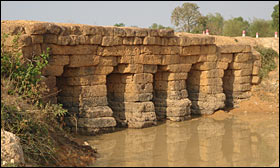

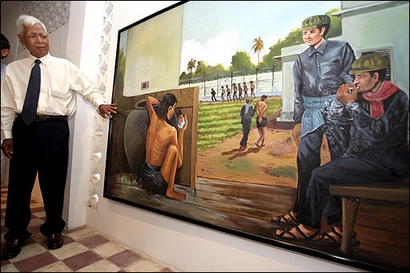 Cambodian artist and genocide survivor Vann Nath stands by one of his paintings - photo by Tang Chhin Sothy (AFP).
Cambodian artist and genocide survivor Vann Nath stands by one of his paintings - photo by Tang Chhin Sothy (AFP).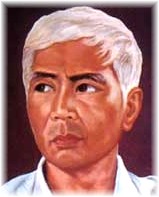 Thirty years ago this December, celebrated Cambodian artist Vann Nath was arrested, accused of being a CIA agent and interrogated at Kandal pagoda in Battambang before being transported to Phnom Penh where he spent exactly one year in the hell-hole that was Tuol Sleng, the nerve centre of the Khmer Rouge killing machine. He survived and his current exhibition of paintings at the Bophana Audiovisual Resource Center (at Street 200), which lasts until 12 October, tell the story of his arrest, transfer and the first few months of his imprisonment at Tuol Sleng.
Thirty years ago this December, celebrated Cambodian artist Vann Nath was arrested, accused of being a CIA agent and interrogated at Kandal pagoda in Battambang before being transported to Phnom Penh where he spent exactly one year in the hell-hole that was Tuol Sleng, the nerve centre of the Khmer Rouge killing machine. He survived and his current exhibition of paintings at the Bophana Audiovisual Resource Center (at Street 200), which lasts until 12 October, tell the story of his arrest, transfer and the first few months of his imprisonment at Tuol Sleng. photo by Scott Smeltzer / Press-Telegram
photo by Scott Smeltzer / Press-Telegram Asian rare bird first to benefit from world’s largest bird conservation programme from BirdLife International.
Asian rare bird first to benefit from world’s largest bird conservation programme from BirdLife International.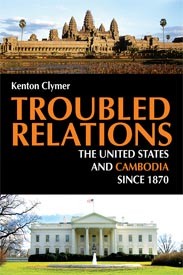 Book Review
Book Review